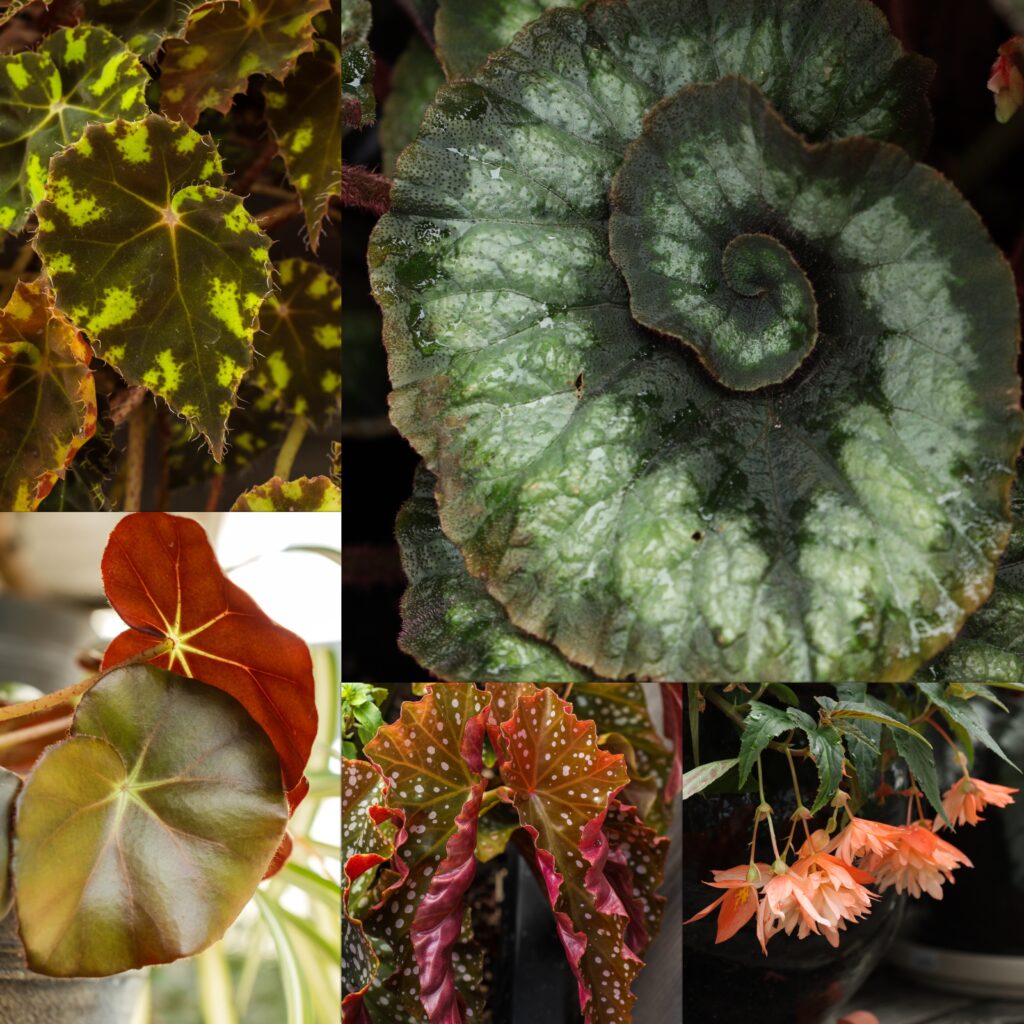By Sue Healey, Tillsonburg Horticultural Society
The cold reality of November usually hits me in the garden. Most often, it’s late in the day and raining and I am struggling to find space in the already packed beds for that last bulb or plant or bush that I so blithely bought in the spring. There, with wet shoulders and numb hands, I realize it’s November and there was snow last night. The growing year is over. Whatever plans I had for the garden will now have to wait until spring. And while I love the austere beauty of winter, the loss of light and colour isalways keenly felt. It’s this time of year that I appreciate my potted plants most. While outside is bare and black, the indoor garden is alive and growing. My collection of indoor plants has just come in from their summer outdoors and most are at their finest. None more so, than the begonias. This large and diverse family of plants, with colourful leaves and outlandish shapes, is an excellent way to dispel some of the gloom November can bring. Their care, a healthy distraction from the shortening days and worsening weather.
While I grow a paltry few begonia, there are thousands of varieties to be had. One could easily fall down the rabbit hole of collection. There are three main categories: 1) fibrous rooted, examples include angel wing and wax, 2) tuberous, container plants featuring prominent flowers and 3) rhizomatous, grown for fabulous foliage. Over the decades I have grown all three types and found outstanding examples of each.
For outdoor hanging baskets or mixed containers, tuberous begonias with their Day-Glo blossoms offer a wide selection of both colour and form. With blooms in white to fuchsia and every shade in between, this variety is best with some sun during the early part of the day and consistent moisture. The leaves can be large and jagged, sometime suffused with colour, depending on the variety. But they are mostly overshadowed by the exquisite, double blossoms reminiscent of piped icing flowers. A well grown blooming begonia is a showstopper as a specimen. Plants can be overwintered from year to year by storing tubers in peat or sawdust in shallow trays and replanting in spring. More often, they are treated as annuals.
Fibrous begonias include both the bedding type, often referred to as wax begonias and the angel wing begonias. Wax begonias have been used for decades in outdoor public gardens and make good filler, taking more sun than most in their family. Angel or dragon wing type offer outstanding foliage with leaves held in pairs, often with jagged edges and silver markings. Frost tender and usually grown as a houseplant, the canes can be pruned to maintain a bushier, shorter profile. In late winter, small bunches of pink or red blossoms dangle among the leaf bracts. Bright, indirect light and consistent moisture will keep these begonias going for years.
For spectacular foliage, the rhizomatous begonia reigns supreme. No other plant can rival the range of leaf colour and form that this category encompasses. The Rex series includessome of the most dramatic plants available to the average gardener. Extensive breeding and hybridizing have resulted in otherworldly combinations. Some boast huge leaves, glinting like metallic shields, veins etched in contrasting red or purple. “Escargot” is a fine and popular example, it’s leaves made of impossible swirls of silver and green.
The large leaved Rexvarieties are at their best grown outdoors where summer light and humidity are ample. They are less amiable to overwinter but worthy of the effort. Smaller divisions and a cool, bright room with good air circulation is the best starting point. Easier to grow and keep, if less flashy, is beefsteak begonia (Begonia erythrophylla). This stalwart old favourite was introduced in1845 and it’s glossy, plate sized leaves have been gracing ourwindowsills ever since. Tough and resilient, I use it as a houseplant in dim rooms, the deep green leaves getting larger (but fewer) the farther away the light is. In bountiful light, the leaves will pleat and ruffle in their rush to expand. In outdoor containers, it makes a good foil for showier begonias, ferns or primrose.
Easily propagated but hard to find in shops, your best bet is a gardening friend or neighbourhood plant sale. Mine came as gift, wrapped in a wet paper towel one cold December day, 20 years ago. It has been nick-named Maida’s begonia ever since.
Smaller rhizomatous versions come in hot pink, silver, or lime green. My favourite drapes over it’s pot with leaves like eyelids streaked with neon and edged in winking lashes. Begonia bowerae forms small, neat mounds on long winding stems. It isa hardy plant, easily adaptable to any but the darkest environments. But given a cool spot where it can stretch towardsbright light, moist but not damp soil, this begonia will bloom in late winter. Thin, foot long stems shoot out over it’s mounding leaves, dangling ballerina-pink blossoms for a month or more. There is a daily shower of papery husks, its cleanup gladly done, a small price for the gift of beauty on early winter days.
Lift the November blues with the gift of sharing and society. Your local Horticultural Society holds regular meetings, fundraisers and workshops – a great way to spend an evening, meet some interesting people and learn something new.
November’s featured speaker is Sharon Bowler, author, historian, teacher and gardener. Sharon will present “Four Seasons of Winter Hardy Cactus”
Tuesday, November 5, 2024, Tillsonburg Seniors Centre, 7:30 pm. $20/year $4/meeting
“Come as guest, stay as a member.”
📷Sue
